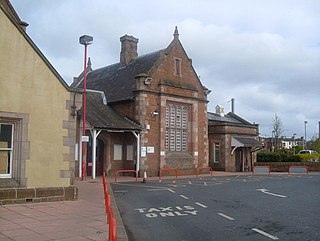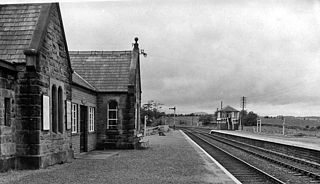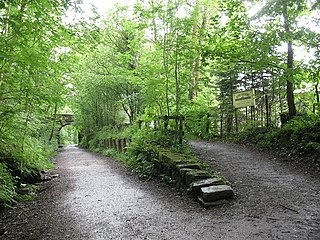Related Research Articles

The Eden Valley Railway (EVR) was a railway in Cumbria, England. It ran between Clifton Junction near Penrith and Kirkby Stephen via Appleby-in-Westmorland.
The Cockermouth, Keswick and Penrith Railway (CK&PR) was an English railway company incorporated by Act of Parliament on 1 August 1861, to build a line connecting the town of Cockermouth with the London and North Western Railway (LNWR) West Coast Main Line at Penrith. Arrangements for the use of the stations at either end were included. Passenger and goods traffic was worked by the LNWR and mineral traffic by the North Eastern Railway, both of whom had shares in the company. The line was 31+1⁄2 miles (50.7 km) in length, and had eight intermediate stations.

Penrith North Lakes railway station is located on the West Coast Main Line in the United Kingdom. It serves the town of Penrith, Cumbria, and is less than 1 mile (2 km) from its centre. National Express coaches leave from the station's car park and there are bus links to Keswick, Workington, Appleby-in-Westmorland and Ullswater.

Blencow railway station was situated on the Cockermouth, Keswick and Penrith Railway between Penrith and Cockermouth in Cumberland, England. The station served the villages of Blencow and Newbiggin. The station opened to passenger traffic on 2 January 1865, and closed on 3 March 1952. It reopened temporarily on 2 July 1956 before closing permanently on 6 March 1972.

Penruddock railway station was situated on the Cockermouth, Keswick and Penrith Railway between Penrith and Cockermouth in Cumberland, England. The station served the villages of Penruddock and Motherby. The station opened to passenger traffic on 2 January 1865, and closed on 6 March 1972.

Troutbeck railway station was situated on the Cockermouth, Keswick and Penrith Railway between Penrith and Cockermouth in Cumberland, England. The station served the hamlet of Troutbeck. It opened to passenger traffic on 2 January 1865, and closed on 6 March 1972.

Threlkeld railway station was situated on the Cockermouth, Keswick and Penrith Railway between Penrith and Cockermouth in Cumbria, England. The station served the village of Threlkeld. The station opened to passenger traffic on 2 January 1865, and closed on 6 March 1972.

Keswick railway station was on the Cockermouth, Keswick and Penrith Railway between Penrith and Cockermouth in Cumberland, England. It served the town of Keswick and accommodated the offices of the Cockermouth, Keswick and Penrith Railway Company.

Bassenthwaite Lake railway station was situated on the Cockermouth, Keswick and Penrith Railway between Penrith and Cockermouth in Cumbria, England. The station served the village of Dubwath.

Embleton railway station was situated on the Cockermouth, Keswick and Penrith Railway between Penrith and Cockermouth in Cumberland, England. The station served the village of Embleton. The station opened to passenger traffic on 2 January 1865, and closed on 15 September 1958.

Cockermouth railway station was situated on the Cockermouth, Keswick and Penrith Railway and served the town of Cockermouth, Cumbria, England.

The original Cockermouth railway station was the eastern terminus of the Cockermouth & Workington Railway. It served the town of Cockermouth, Cumbria, England.

Brigham railway station was situated on the Cockermouth and Workington Railway at its junction with the Maryport and Carlisle Railway's Derwent Branch. It served the village of Brigham, Cumbria, England.

Broughton Cross railway station was situated on the Cockermouth and Workington Railway and served the village of Broughton Cross, Cumbria, England.

Camerton railway station was situated next to the River Derwent on the Cockermouth and Workington Railway. It served the village of Camerton, Cumberland, England.
The Cockermouth & Workington Railway was an English railway company which built and operated a railway between the Cumberland towns of Workington and Cockermouth. The railway opened for service in 1847, and ran from the Whitehaven Junction Railway station at Workington to a station at Cockermouth near the bridge over the Derwent. A single-tracked line of eight and a half miles length, its revenue came largely from the transport of coal from the pits of the lower Derwent valley to the port at Workington for shipment by sea. The Marron extension of the Whitehaven, Cleator and Egremont Railway and the Derwent Branch of the Maryport and Carlisle Railway were both constructed to link with the C&WR and together give an alternative route for the northward movement of haematite ore from the Cumberland ore-field. The completion of the Cockermouth, Keswick and Penrith Railway made the C&WR part of a continuous through route between South Durham and the Cumberland orefield. These developments both improved the potential profitability of the C&WR, and made control of it important to bigger companies wishing to maximise the iron-ore traffic over their lines: the C&WR was absorbed by the London and North Western Railway in 1866.

Great Broughton railway station briefly served the village of Great Broughton, near Cockermouth in Cumberland, England.

Marron Junction railway station was a later addition to the Cockermouth and Workington Railway. It opened on 2 April 1866 with a single, eastbound, platform when the adjacent Marron Junction opened, two months before the company was absorbed by the London and North Western Railway.

Linefoot railway station, sometimes referred to as Linefoot Junction and sometimes as Linefoot Goods, briefly served the scattered community around the crossroads at Linefoot, near Cockermouth in Cumberland, England.

Briery Siding Halt railway station served the workers of Briery Bobbin Mill in Briery, in the historical county of Cumberland, England, from 1922 to 1958 on the Cockermouth, Keswick and Penrith Railway.
References
| Preceding station | Disused railways | Following station | ||
|---|---|---|---|---|
| Threlkeld Line and station closed | Cockermouth, Keswick and Penrith Railway | Troutbeck Line and station closed |